树冠高度变化对有限植被周围流动特性的影响
IF 1.4
Q4 WATER RESOURCES
Journal of Applied Water Engineering and Research
Pub Date : 2022-08-12
DOI:10.1080/23249676.2022.2110165
引用次数: 1
摘要
有限长度的植被先前已经被研究过,因为它只使用树干部分的树木结构来提供抵抗海啸的能力。然而,在考虑树冠剖面的同时调查植被的恢复能力尚不清楚。利用有限突生植被模型(EVM),研究了树冠高度变化对植被及其周围林隙间流动结构行为的影响。实验变量包括树冠高度(其中为离地面的树冠高度,为总树高)、植被宽长比(W/L)和初始弗劳德数条件,其取值范围为0.67 ~ 0.76。结果表明:当植被宽长比较小时,冠高比(< 0.3)较无冠高比(NC)和最高冠高比(> 0.3)显著降低了植被斑块区域后的流速和流体力;另一方面,与NC相比,小植被斑块中冠状体的影响没有增加间隙区域的速度和流体力。植被斑块宽度随冠高比的降低(< 0.4)而增大,进一步降低了植被斑块背后的速度和流体力,而植被斑块宽度随冠高比的降低而增大,与NC情况相比,增加了周围间隙区的速度和流体力。本文章由计算机程序翻译,如有差异,请以英文原文为准。
Variation of tree crown height effects on flow behavior around finite vegetation
Finite-length vegetation has been previously studied for its ability to provide resistance against the tsunami by using just the trunk section of the tree stand structures. However, investigating the resilience of the vegetation while taking the crown section into account is yet unknown. Using a limited emergent vegetation model (EVM), this research examined the impact of changing the tree crown heights on the flow structure behavior between the vegetation and its surrounding gap region. Experimental variables included such as tree crown height ( in which is the crown height from the ground surface and is the total tree height), vegetation width to length ratio (W/L), and the initial Froude number condition , which ranged between 0.67 and 0.76. The outcomes demonstrated that, when the vegetation width to length ratio was small, the crown height ratio ( < 0.3) significantly reduced the velocity and fluid force behind the vegetation patch region as compared to no crown (NC) and highest crown height ratio ( > 0.3). On the other hand, the effect of crown cases in the small vegetation patch did not increase the velocity and fluid force in the gap region in comparison with NC. Whereas the increased width of the vegetation patch along with the lower crown height ratio ( < 0.4) further decreased the velocity and fluid force behind the vegetation patch but the increased width of the vegetation patch in combination with the lower crown height ratio increased the velocity and fluid force in the surrounding gap region as compared to its NC case.
求助全文
通过发布文献求助,成功后即可免费获取论文全文。
去求助
来源期刊

Journal of Applied Water Engineering and Research
WATER RESOURCES-
CiteScore
2.90
自引率
16.70%
发文量
31
期刊介绍:
JAWER’s paradigm-changing (online only) articles provide directly applicable solutions to water engineering problems within the whole hydrosphere (rivers, lakes groundwater, estuaries, coastal and marine waters) covering areas such as: integrated water resources management and catchment hydraulics hydraulic machinery and structures hydraulics applied to water supply, treatment and drainage systems (including outfalls) water quality, security and governance in an engineering context environmental monitoring maritime hydraulics ecohydraulics flood risk modelling and management water related hazards desalination and re-use.
 求助内容:
求助内容: 应助结果提醒方式:
应助结果提醒方式:


